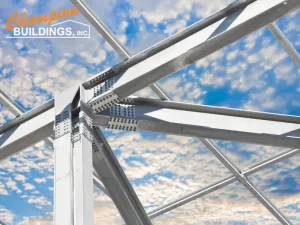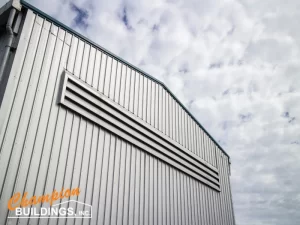Metal buildings have become one of the most popular choices for commercial, residential, and agricultural projects. Compared to traditional construction methods, steel buildings offer superior structural integrity, cost savings, and design flexibility. However, understanding how climate affects the durability of metal buildings is essential before beginning any metal building project.
Join our pre-fabricated metal building experts from Champion Buildings Inc. as we explore how weather conditions directly influence the maintenance needs, energy efficiency, and overall longevity of steel structures.
Table of Contents
How Climate Affects Durability of Metal Buildings
The ability of metal garages, metal agricultural buildings, metal workshops, and other metal buildings to stand strong depends on their environment. Different weather conditions create unique challenges for homeowners and business owners who rely on their steel buildings’ performance year-round.
Cold Climates and Freeze-Thaw Cycles
In northern regions, cold climates with repeated freeze-thaw cycles place stress on joints, insulation, and concrete foundations. Without proper insulation, gaps expand and lead to water infiltration, reducing structural stability.
Hot Climates and UV Exposure
Hot climates expose metal panels to extreme temperatures that can cause paint fading, surface chalking, and weakened protective coatings. Selecting finishes like powder coatings or a protective zinc coating can enhance durability and help metal buildings withstand high temperatures.
Coastal Regions and Corrosion
In coastal areas, harsh weather conditions and salt-laden air speed up rust. Galvanized steel prevents corrosion and structural damage, due to its protective layers. Choosing quality materials for a steel building project in these regions ensures long-term corrosion resistance.
Heavy Snow Loads and Structural Stress
Northern climates demand designs that address snow loads and heavy snow. Engineers use structural reinforcements, pitched roofs, and frames rated for heavy snow loads to prevent collapse and maintain structural engineering standards.
Moisture, Humidity, and Corrosion: The Hidden Threat
One of the critical factors for long-term performance is how metal buildings—whether commercial metal buildings, metal community buildings, or steel buildings for residential use—respond to moisture.
Rust and Corrosion Risks
High humidity and heavy rain accelerate rust. Choosing galvanized steel or pre engineered metal buildings with factory-applied corrosion resistant coatings protects against deterioration.
Proper Drainage and Vapor Barriers
An appropriate foundation with gravel foundations or reinforced concrete paired with vapor barriers helps control condensation and water runoff at the building site.
Mold and Mildew Issues
Poor airflow in humid climates leads to mold and mildew inside steel structures. Installing ventilation and using proper insulation helps maintain indoor air quality.
Designing Metal Buildings for Climate-Specific Durability
When planning a steel building kit or construction project, tailoring the design to local weather patterns is essential for long-term performance. Each climate presents unique challenges, from extreme temperatures to heavy snow loads, that should be addressed during the construction process.
Custom Insulation for Extreme Temperatures
Enhanced insulation systems are a must for regions that face extreme temperatures in either hot or cold climates. Proper insulation not only improves comfort but also increases energy efficiency, reduces condensation, and protects against damage caused by temperature fluctuations.
Ventilation Systems in Humid Regions
In areas with high humidity or frequent heavy rain, ventilation plays a critical role in protecting steel buildings. Effective ventilation systems prevent moisture buildup, which can otherwise lead to mold, mildew, and corrosion of internal building materials.
Protective Coatings for Harsh Weather Conditions
Applying protective coatings, protective layers, or corrosion resistant coatings is one of the most effective ways to combat harsh weather conditions. These treatments shield metal panels from rust, UV exposure, and abrasion caused by wind or debris. With the right finish—such as galvanized steel with a protective zinc coating—metal buildings provide long-term durability.
Structural Reinforcements in Snow Zones
Regions prone to heavy snow loads require thoughtful structural engineering during design. Roof pitch adjustments and framing designed to meet load capacity requirements reduce risks of collapse and maintain structural stability under pressure.
High-Wind Engineering
In coastal or hurricane-prone areas, wind resistant metal buildings must be designed to withstand high winds and severe weather events. Engineers often add bracing, anchoring systems, and roof designs that maximize weather resistance. By adhering to local building codes and integrating these features, pre engineered metal buildings can perform better than many traditional construction methods when facing storms and unpredictable weather.
Seasonal Tips to Extend the Life of Metal Buildings
Even when built with high quality materials, metal buildings still require ongoing care to maximize performance. By following a regular maintenance plan, owners can prevent costly repairs and extend the building’s lifespan through every season.
Summer Steel Building Maintenance

- Inspect exterior surfaces for fading or UV damage.
- Reapply protective coatings or paint where necessary.
- Clean roof and wall panels of dirt, pollen, and debris.
- Check ventilation systems to maintain energy efficiency.
- Inspect doors, windows, and seals for gaps caused by temperature fluctuations.
Fall Maintenance for Metal Buildings
Fall is the best time to prepare for harsh weather conditions and fluctuating temperatures. Proper care ensures your building is ready to handle snow, wind, and moisture in the months ahead.
- Clear gutters, downspouts, and drainage areas of leaves and debris.
- Inspect and reseal windows, doors, and joints before winter.
- Check the roof for loose fasteners or compromised panels.
- Ensure protective layers are intact to prevent rust.
- Confirm insulation and weather stripping are in good condition.
Winter Metal Building Maintenance
In cold climates, winter brings heavy snow, ice buildup, and potential condensation issues. Monitoring your structure prevents damage and maintains its overall stability.
- Regularly remove snow and ice from the roof to avoid overload.
- Watch for ice damming near gutters and eaves.
- Inspect for condensation inside the building and improve ventilation if needed.
- Check heating systems for efficiency and leaks.
- Ensure entrances and exits remain clear of snow and ice for safety.
Spring Maintenance for Steel Buildings
Spring is the ideal time to inspect for winter wear and prepare for warmer weather conditions. This seasonal upkeep helps enhance durability and ensures the structure remains weather resistant year-round.
- Conduct routine inspections for rust or corrosion on panels and fasteners.
- Repaint or recoat exposed surfaces as needed.
- Verify that drainage systems are directing water away from the concrete foundation.
- Inspect for cracks or damage from freeze-thaw cycles.
- Clean gutters, siding, and roof areas to prevent buildup.
Build with Climate in Mind at Champion Buildings
Whether you’re starting a steel building project for agriculture, business, or residential use, factoring in how climate affects metal building durability ensures its long-term performance.
Ready to start your climate-ready build? Contact Champion Buildings today to request a quote and learn how we can design a structure built to last. Get started now by calling us at (800) 942-6812 or filling out our online contact form below.

